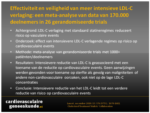Grotere reductie van LDL-C leidt tot verdere verlaging van vasculaire events
Nieuws - 7 jan. 2011 | Grotere reductie van LDL-C leidt tot verdere verlaging van vasculaire events3-1-2011 Download de PPT slide |
studies waarin meer dan 1000 patienten werden geincludeerd, en uiteindelijk een analyse van gegevens van 170.000 patienten plaatsvond. Intensieve versus minder-intensieve statineregimes én statines vergeleken met controles werden geincludeerd. Uit de resultaten blijkt dat er geen ondergrens voor LDL cholesterolverlaging te geven is; hoe sterker de reductie in LDL cholesterol, des te sterker de reductie in vasculaire complicaties. Lees onderstaand het volledige artikel.
Lancet. 2010; 376: 1670-1681
Cholesterol Treatment Trialists' Collaboration
CTT Collaboration finds no evidence of lower threshold for LDL-C
A meta-analysis of 26 trials with 170,000 participants demonstrated further reductions in the risk of major vascular events with more intensive LDL-C lowering, even in those with low baseline LDL-C.Background: As demonstrated by the CTT (Cholesterol Treatment Trialists') Collaboration and others, reduction of low-density lipoprotein cholesterol (LDL-C) with statins is an effective treatment for reducing the risk of major vascular events. Recently, the CTT Collaboration performed a meta-analysis to evaluate the safety and efficacy of more intensive LDL-C lowering.
Methods:
Randomized trials of LDL-C lowering were included if >1000 participants were recruited and treatment was scheduled for at least 2 years. More- vs less-intensive statin regimens and statin vs control methodologies were included. Both the average risk reduction (RR) and the average RR per 1.0 mmol/L (39 mg/dL) LDL-C reduction of major vascular events at 1 year were assessed. Major vascular events were defined as a major coronary event, coronary revascularization, or stroke. Other prespecified outcomes included cause-specific mortality, major coronary event (coronary death or nonfatal myocardial infarction [MI]), coronary revascularization (angioplasty or bypass grafting), stroke, and new cancer diagnosis. Rhabdomyolysis incidence was also examined.
Results:
A total of 26 trials were analyzed, 5 trials employing more- vs less-intensive statin regimens (N = 39,612) and 21 utilizing statin vs control (N = 129,526). In the more- vs less-intensive trials at 1 year:
* Weighted mean LDL-C was 0.51 mmol/L (19.7 mg/dL) lower in the more-intensive group
* More-intensive group showed a further RR of 15% for first major vascular event (95% confidence interval [CI] 11%-18%, P < 0.0001), 15% for nonfatal MI (P < 0.0001), 19% for coronary revascularization (P < 0.0001), and 16% for ischemic stroke (P = 0.005)
* Excess rhabdomyolysis was 4 per 10,000 in the more- vs less-intensive groups (specifically in the 80 mg vs 20 mg qd simvastatin trials)
In the statin vs control trials at 1 year:
* Weighted mean LDL-C was 1.07 mmol/L (41.4 mg/dL) lower in the statin group Statin group showed a further RR of 22% for first major vascular event (95% CI 19%-24%, P < 0.0001)
* Excess rhabdomyolysis was 1 per 10,000 in the statin vs control groups
In all 26 trials combined, for every 1.0 mmol/L (39 mg/dL) reduction in LDL-C at 1 year:
* RR was 22% for first major vascular event (95% CI 20%-24%, P < 0.0001) RR was 27% for nonfatal MI, 20% for coronary death, 21% for ischemic stroke, 10% for all-cause mortality, and 14% for vascular mortality (all P < 0.0001)
* RR was ~20% for first major vascular event in all subgroups examined, including participants with baseline LDL-C <2.0 mmol/L (77.3 mg/dL, RR 29%, P = 0.007), no previous history of vascular disease (RR 25%, P < 0.0001), aged >75 years at randomization (RR 16%, P = 0.002), and women (RR 17%, P < 0.0001)
* No evidence of an increase in cancer risk was seen
Conclusions:
A large meta-analysis of LDL-C lowering trials showed that reductions in major vascular events were directly proportional to the absolute LDL-C reduction achieved.
Comment: "These findings suggest that the primary goal for patients at high risk of occlusive vascular events should be to achieve the largest LDL cholesterol reduction possible without materially increasing myopathy risk," write the authors.

Deel deze pagina met collega's en vrienden: